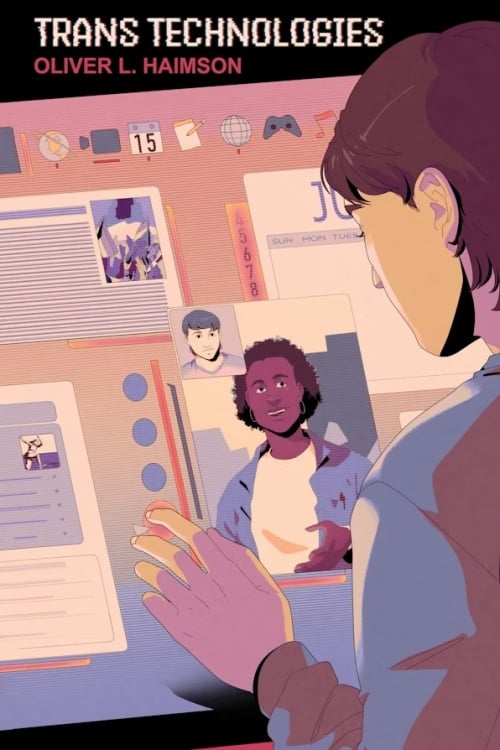
“Technology is anything that extends your agency,” posits Allucquére Rosanne “Sandy” Stone, a foundational trans studies pioneer and digital performance artist included in Trans Technologies, a new book from MIT Press written by trans academic Oliver Haimson. Technology, then, is a near boundless way to intervene in the challenges of every day life, to make it better. But what happens when those in power try to dictate those terms, and attempt to use technology to strip individual agency?
As an expert in trans studies, social computing and social media, and what is known as human-computer interaction, Haimson poses the concept of “technological trans care,” or the act of trans communities and allies “creating innovative technological mechanisms to help address the needs and challenges that they and their communities face.” And if this sounds more relevant to our current political reality than ever before, you’d be right on the money.
Haimson is an assistant professor at the University of Michigan School of Information, director of the Community Research on Identity and Technology (CRIT) Lab, and a Senior Fellow at the Center for Applied Transgender Studies. The genesis of Trans Technologies came from the intersection of these scholarly and lived experiences: The repurposed and self-constructed online worlds that trans communities fashion for themselves in order to navigate a hostile social reality. Forums, Tumblr blogs, Discord servers, and even wholly original platforms present the complexities and ambiguities of the trans experience in a digital environment often fixated on strict gender binaries.
But, in trying to document these digital environments, Haimson quickly realized the term “trans tech” could extend far beyond these networking tools. In their research, for example, Haimson’s team found that the majority of trans technologies were created for resource gathering and the sharing of community knowledge — consider digital services like anti-trans legislation trackers, databases of LGBTQ-inclusive healthcare providers, or maps of queer-friendly businesses and job boards. Other examples expanded to hotlines, peer support networks, plug-ins, and even video games. There’s also technology that isn’t exactly “transed,” as the academic explains, but that inherently affects trans people, like biometric tools (Face ID and filters), ride-sharing apps, and online credit platforms.
“Most technology responds to fairly mundane problems,” writes Haimson. “Problems that are rarely critically related to their creators’ identities and life chances. With trans technology, though, technological innovations are frequently created in direct response to the oppressive conditions trans people face in the social, legal, and medical spheres: transphobia, violence, antitrans legislation, difficulty identifying supportive resources, and lack of access to medical care.”
Haimson describes trans tech as encompassing both technology designed with trans people at the center, as well as advances that respond to an increasingly bigoted use of technology’s power (e.g., the current iteration of X as a locus of transphobic sentiment). With its earliest definition conceived of in 2019, an extension of decades-long queer theory and practice, trans technology is bearing added importance in 2025, when the world seems to be taking a rightward shift and misinformation is more weaponized than ever.
Central to the book’s introduction, Haimson lays out this politically life-threatening reality: In 2023, the period that defined the tail-end of his team’s research, 420 trans people were reportedly murdered amid growing violence, economic instability, and health precarity — keep in mind, these numbers are often vastly undercounted. In the year between the book’s final edits and its upcoming release, those statistics haven’t much improved. In 2024, 350 trans and gender-expansive individuals were murdered globally and 533 anti-LGBTQ bills were introduced in U.S. state legislatures, alone. President Donald Trump regularly takes aim at “gender ideology extremism” and is moving to erase LGBTQ resources, information, and history from federal websites.
Trump’s technological allies have offered little resistance; more often, assistance. Elon Musk, multi-billionaire and now leader of DOGE, has taken over federal technologies in the name of an anti-woke, anti-fraud agenda. Mark Zuckerberg, CEO of Meta, repealed his company’s DEI commitments and hateful conduct policies — a move that will certainly lead to a rise in online hate and harassment. Sam Altman, CEO of OpenAI, has funneled cash into Trump’s push for power.
Mashable spoke to Haimson in the weeks before Trans Technologies’ debut, as the federal government slashed gender-affirming care and inclusive hiring practices — including a devastating pause on federal academic funding via the National Science Foundation, of which Haimson’s team receives assistance — and just as federal courts began slowing down the new administrations’ anti-trans orders.
Could trans tech be another tool to fight back?
Mashable: You began your research and the extensive interviewing process that makes up the bulk of this book in 2021, following a surge of anti-trans legislation. How did that influence this work and what has changed?
Haimson: When I was first writing the book as all of this anti-trans legislation was happening across the country, starting in Texas and Florida and Idaho, trans people were angry. I was able to talk about all of these trans technologies that came about in response to that climate.
We’re in this new moment, where people are feeling very scared, very angry. I think that a lot of the things I found that were happening a couple years ago, where people were creating these really important technologies to respond to that moment, we’re going to see again. The one thing that is quite different now is that we’ve always thought about how we can improve mainstream platforms, like Instagram (owned by Meta). ‘How can we make that more inclusive?’
Meta seemed on board with that for most of the years I’ve been doing research in this space, and then it was just recently that Zuckerberg came out and changed his orientation entirely. So that’s not a priority for mainstream platforms — they have no intention really of including trans people anymore. That makes me feel like this moment for trans technology is so important. It’s so vital to have these alternative technologies, because we can’t rely on mainstream platforms, and we can’t even try to make them better because they are not on board with inclusion anymore.
The book defines two ways of looking at the design of trans tech: technological inclusionism, or the process of marginalized groups attempting to fit into and improve existing tech, and technological separatism, or tech designed outside of the mainstream for trans communities, specifically.
There are so many cases where people are creating these trans technologies, taking this separatist approach where they’re creating it specifically for a marginalized group, but then it connects to a mainstream platform. For instance, I talked to a lot of people who are creating browser extensions. For example, [extensions] that would take any instance of your dead name that you’re not using anymore and you don’t want to see, and it would change it in the HTML code in a browser, so you would only see your current name. That’s something that’s fitting in with, usually, Chrome, which is a very mainstream platform. It’s a way that we can adjust something like Google Chrome to be more inclusive, but at the same time it’s its own technology that’s really just designed for this group.

Credit: C.D. Rom / Kat Brewster / MIT Press
One premise of this book is that trans-exclusionism is baked into many mainstream platforms — but that is because of human intervention, not the natural outcome of technological progress. Can you explain more?
Toward the end of the book, I quote from Stone’s [The War of Desire and Technology at the Close of the Mechanical Age] where she said it’s natural to be trans in digital spaces. She was writing this in the 1990s and talking about how digital spaces were often so much more comfortable for trans people or for people who are exploring their identity in different ways.
[Editor’s note: The full quote is “Transness is natural online, while physical spaces can feel unnatural. Technology is like water to us — we need it to survive; we can breathe here.”]
I don’t think that Mark Zuckerberg would really think about [his technology] like that at all. Zuckerberg famously said that each person only has one identity, and so that is why Facebook wants you to use your real name and why you shouldn’t have multiple accounts. All of that stems from his fundamental belief that each person only has the one identity. These types of values are embedded in and baked into these mainstream platforms because of someone like Zuckerberg — who has a relatively simple identity, who doesn’t experience intersectionality in the way that a lot of people who are using his platforms do.
Coming from his own perspective, he has created this giant company that billions of people across the world are using that has this fundamentally flawed assumption.
They want to position it as tech is neutral. Those of us who think about technology in a more critical way definitely consider tech not to be neutral. It’s really influenced by the people who are creating it and the values that are embedded.
Now, the industry’s favored phrase is “tech for good,” or, most common these days, “AI for good.” I feel like this has a completely different meaning for designers of trans technologies, versus huge tech giants like OpenAI.
Before AI, we had ‘data science for good.’ I’ve done work in that space, too. And the challenge here is that, even if your intention is to do good with this emerging technology, a lot of times people are just sitting at their computer, or with a small group of also very highly educated, very technical people, and deciding what ‘good’ means, what the problems that need to be solved are. One of the big things that I’m arguing in the book is that it really needs to start more with communities.
It appears to me then that Big Tech’s leaders are taking a very narrow view of what technology means and how it can serve people. How does that fit into other changes in the industry, like Musk’s reimagining of the federal government as a tech startup via DOGE?
Musk has always taken a very individualist approach. ‘What is my good idea?’ “What do I want to see with this technology?’ He wants a rocket to go into space, so that’s what he’s going to do. It’s the opposite of taking a community- based or needs-based approach, which I argue is so important. He would never go out and try to see what people in the U.S. actually want and need. He’s really just interested in two things: What he wants, and what’s going to make money — or “efficiency.”
We’ve seen what happened to Twitter when he turned it into X. He made it very, very efficient by firing pretty much their whole content moderation staff, who were trying to make it a more safe and positive platform for a lot of people. A lot of marginalized groups have gone elsewhere. And so, if we take that as a metaphor for what’s going on in the U.S. more broadly right now, I don’t think it’s going to have very good outcomes.
Fundamentally, do you believe that the creation of trans technology can be a form of resistance as the state directly attacks trans communities?
Trans technology is huge for being able to resist what’s going on politically. Think about the language of the executive order that said there’s only two genders. They’re trying to impose that across all of the federal government and anyone who’s funded by the federal government. That covers a wide range of organizations and technological systems in the U.S. But what they can’t touch is people’s own identities and the language that people are using to think about themselves, to think about their own genders and the people around them. That’s something that nobody can take away.
As long as we’re building technologies outside of mainstream systems, [the U.S. government] also can’t touch that.
People are frustrated and scared and everything is so chaotic. But there is a really optimistic side of me that sees that all of these people’s anger and frustration is going to lead to really incredible outcomes that can actually help their communities.
“Trans Technologies” was a collaborative project, with additional support from researchers Kai Nham, Hibby Thach, Aloe DeGuia, Samuel Mayworm, Denny Starks, Kat Brewster, F. Ria Khan, and Mel Monier. The book is available on February 25, 2025.







